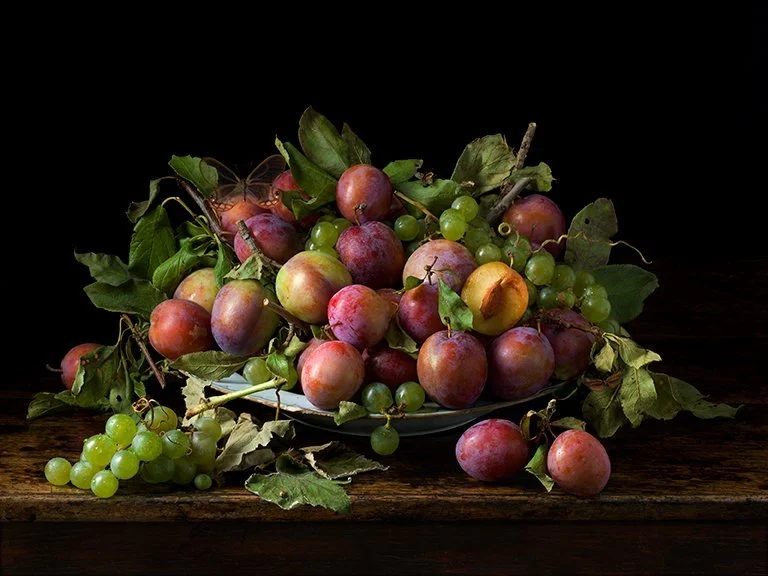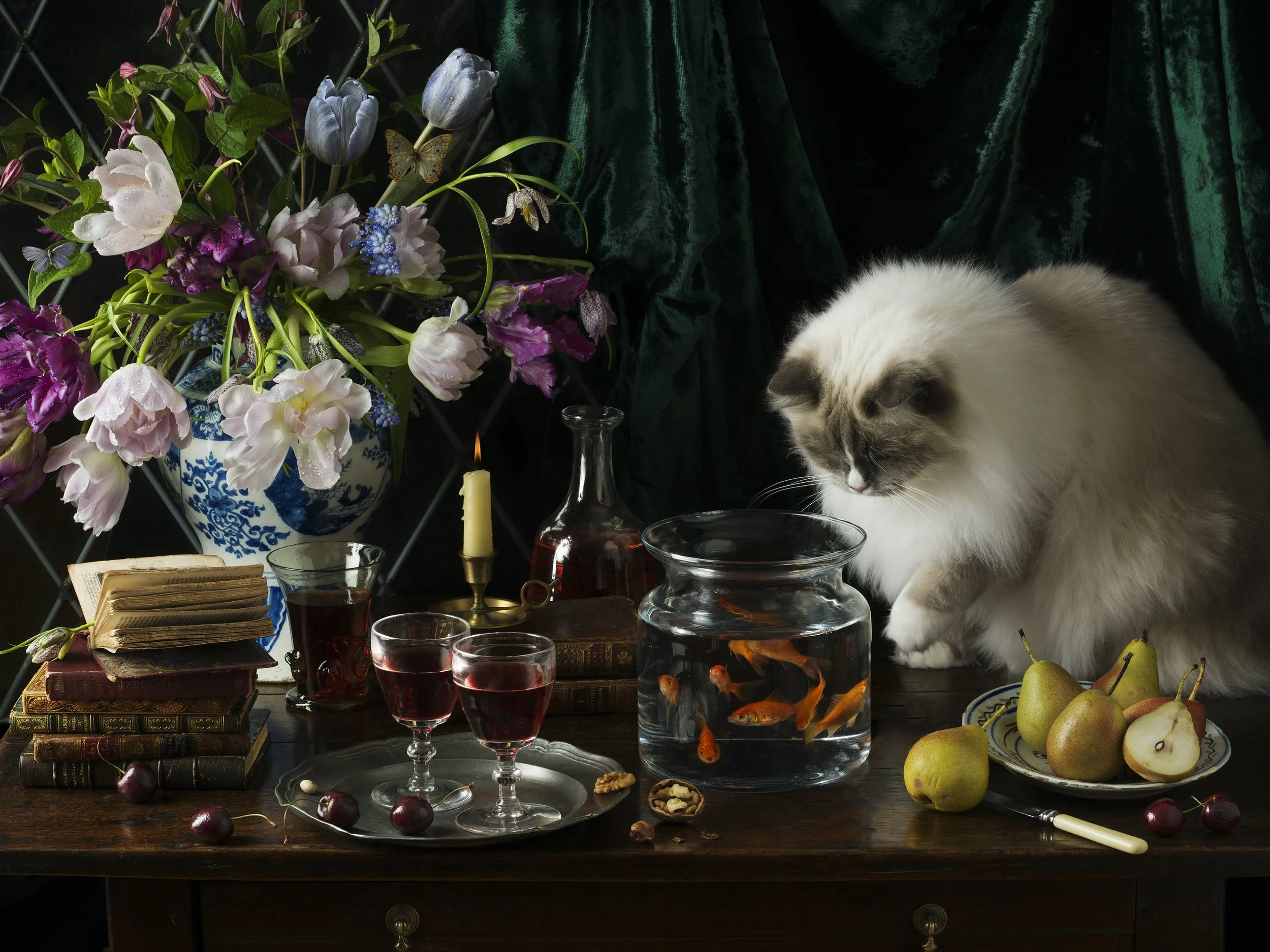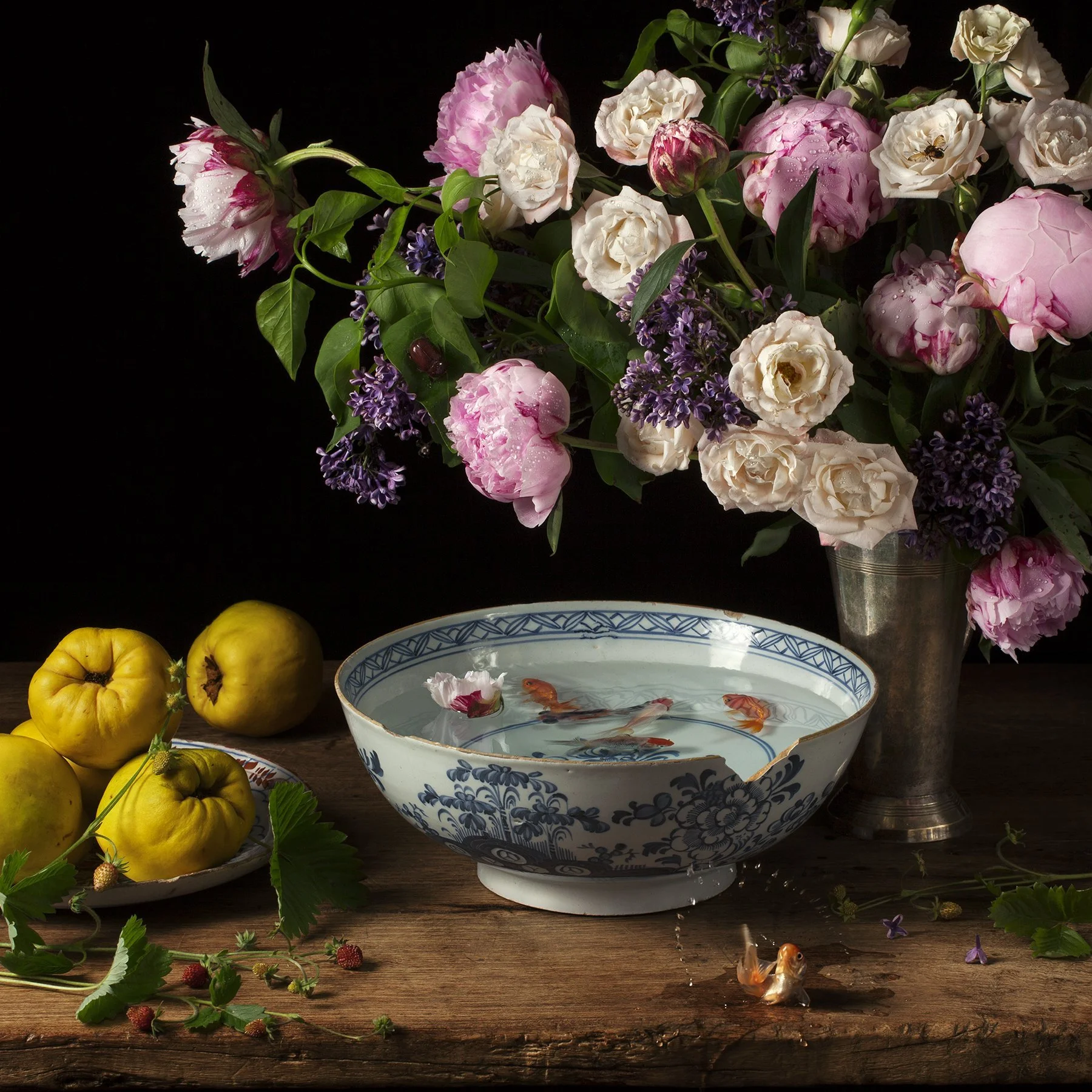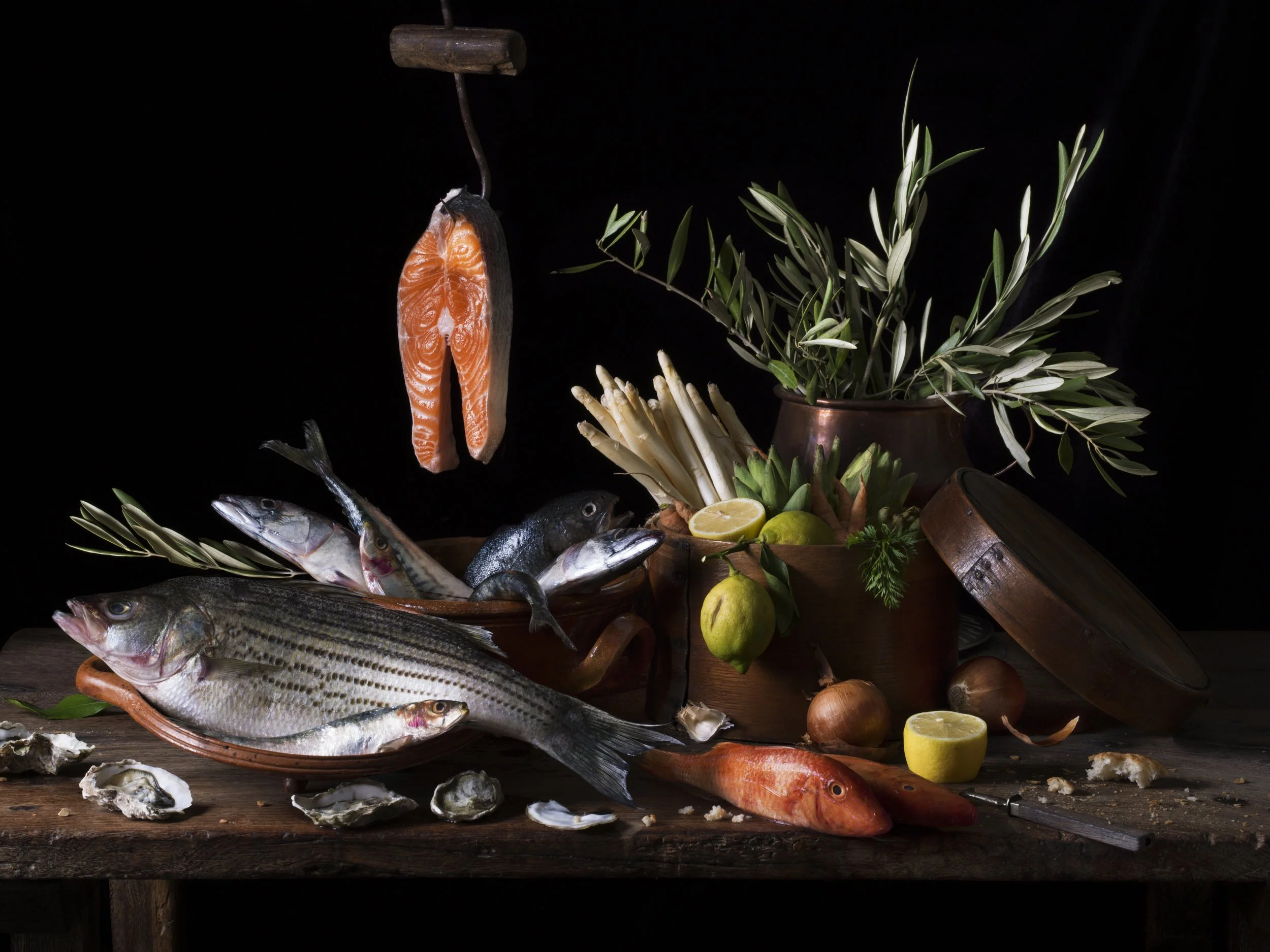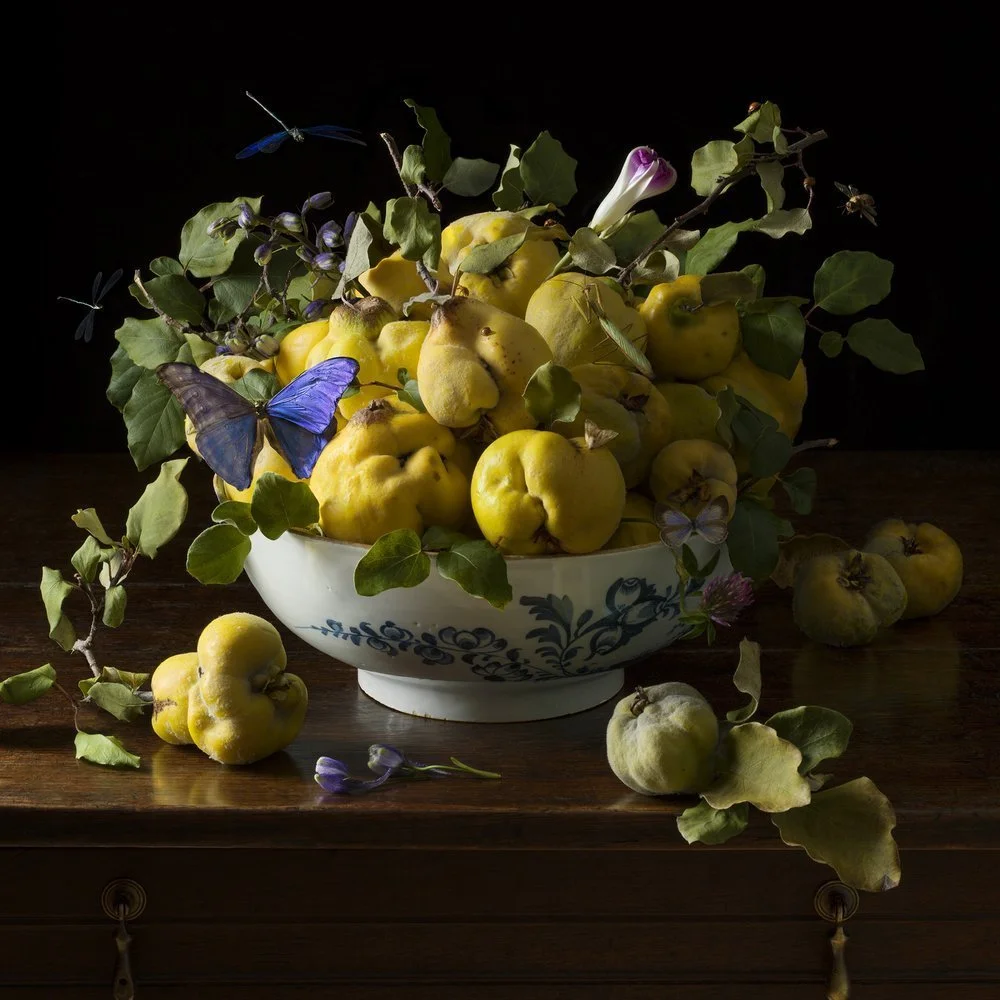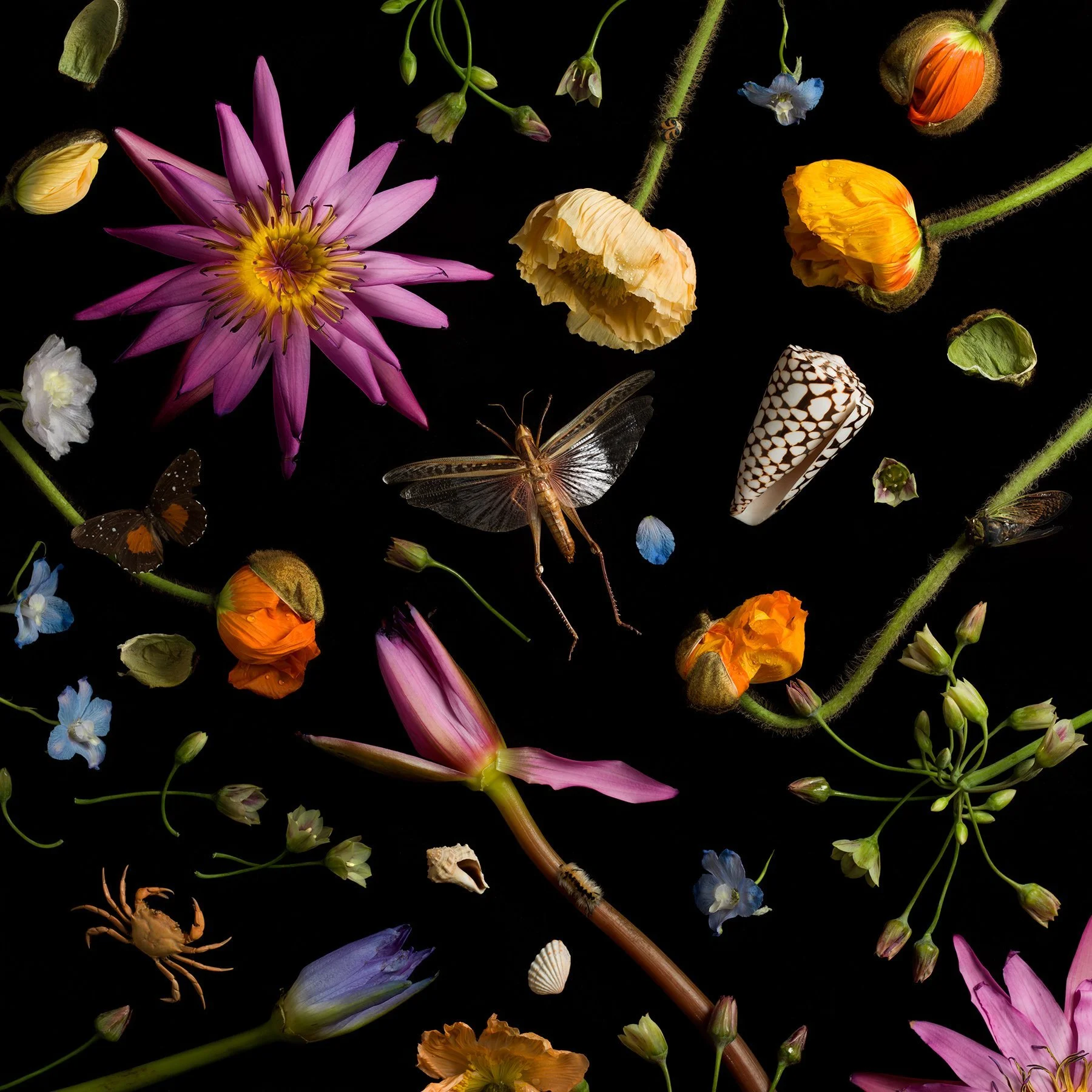PAULETTE TAVORMINA DELIVERS OLD MASTERS FOR THE MODERN AGE
All Images Courtesy of Paulette Tavormina.
When I first came across the photographs of Paulette Tavormina, I was instantly hooked. These beautiful, dark, rich compositions looked like they sprang right out of a book of Old Master Paintings, yet they were contemporary photographs! I was so drawn to the colors and the gorgeous fruits and flowers she uses in her still life compositions that I just had to investigate further. Below is my Interior Dialogue with Paulette, where we talk inspiration, learning through hands-on experience, and the unexpected surprises that keep work interesting and enlivening!
Paulette’s latest monograph, Seizing Beauty, is available now from The Monacelli Press. She also just had a solo museum show at Academy Art Museum in Easton, Maryland. The show will travel to The Snite Museum of Art at Notre Dame University September 8 – November 27, 2016. Paulette has also partnered up with famed New York City restaurant, Del Posto to photograph their forthcoming cookbook, due out this November.
Interior Monologue: What drew you to the Old Dutch Master painters for inspiration?
Paulette Tavormina: It started around 20 years ago. I was living in Santa Fe, New Mexico and photographing historic Indian pottery and Navajo jewelry. I fell in love with the work of a very dear friend of mine, Sarah McCarty, who paints with egg tempera very much in the natura morta style. She introduced me to two amazing women painters, one from the Renaissance, Giovanna Garzoni, and Maria Sibylla Merian, a naturalist painter who illustrated the metamorphosis of butterflies. I would go to the Met, or to the Louvre while traveling to seek out Dutch, Italian, and Spanish Old Master still life paintings. I absolutely fell in love with them—they were always in the back of my mind.
Then, nine years ago I moved back to New York City. I began working for Sotheby’s again (I had worked for them in the past, so was always surrounded by beautiful works of art), photographing their catalogues. I had not been a photographer for a few years, while living in Sicily, so there I was, back with a camera. On weekends I started photographing a dream I had from 20 years earlier of the Old Master paintings that I had fallen in love with. I thought ‘I’m just going to start recreating these myself.’ The first one I photographed was the Fishbone, which has a Venetian glass, a fish skeleton and a wonderful old straw basket that came from a flea market in Paris.
I received such great encouragement from my colleagues at Sotheby’s that I kept on photographing. Every spare moment, I pored through books, went to museums, investigated, and found beautiful paintings that I’ve become so passionate about. From there I started creating photographs in the natura morta theme. That’s how it all started. There was an employee show at Sotheby’s, and I exhibited three photographs. The managing director fell in love with one and bought it. He became my first client, and then it evolved. I created a website, became represented by a well-known photography gallery, and my life changed instantly!
IM: And you create all of the arrangements in your photographs, correct? Can you talk about what that process is like?
PT: Well, for instance last summer I was in the Pennsylvania countryside and wanted to visit an orchard near by, so I called and asked if I could buy fruits, but I wanted to be able to handpick the whole branch, along with the leaves. So this very kind gentleman let me go into the orchards and cut the branches and the leaves so that I would have the whole branch for my composition. There is one photo at the end of the book [Italian Plums, After G.G., 2015], that’s filled with Italian plums. I found them in the orchard – they had a beautiful purple color. The gradation of the purples was just glorious, alongside the branches, and the leaves.
When arranging a photograph, I typically incorporate personal things—for instance, I had been in Sicily to visit my family that summer, so I picked a pomegranate off their tree, which I later added in. And there’s a tiny chestnut pod that I found dropped on the grass at Versailles, so I carry all these things back with me and they tell different stories.
IM: So the still lives really are like collages from all of your travels.
PT: Yes. But the Vanitas series, which is the most recent series I photographed, was a little different. It was a very intense process because I had to create all six under a tight deadline both for the Seizing Beauty book and an upcoming museum show. That involved finding a lot more authentic props than normal. I wasn’t going to the orchards to handpick fruit, I was going to flea markets and antique shops to borrow or rent props. One photo has a little stuffed bird from a Paris flea market, and I found a beautiful tiny brass French scale, which is very similar to one in a Vermeer painting! I’ve always been a collector of objects that have meaning to me. I have an apartment filled with small curios and mementos.
IM: That sounds heavenly! So when you’re putting together an arrangement, you have a library of objects to choose from, do you also go out and seek new things to add?
PT: Yes, it’s a great place to work for me, because I’m surrounded by interesting shells, butterflies and unusual artifacts and I can look through my shelves and boxes and find that perfect little dried flower that I have squirreled away. And I’m always on the lookout for unique objects that I might be able to use one day!
IM: And do you also feel that living in New York City effects the compositions you create? Or are you really pulling mainly from this library of objects that you’ve collected from all around the world?
PT: When I first started working on the natura morta series I was living in New York, so I went to the farmers’ market every weekend and would find the most wonderful, curious looking vegetables. Living in New York City was important because although I couldn’t go to the countryside often, in going to the farmers’ markets I was able to make friends with the growers. For instance, if I wanted grapes with leaves, I would schedule a time with the grower where I would come back and he actually cut the branches and leaves for me. I love being in the city because there is such a myriad of inspirational objects to choose from.
IM: When starting a shoot, do you have a composition in mind? Or does that build and grow as you go?
PT: Sometimes an object inspires me and I build from there, as was the case with the cover photo of the Seizing Beauty book [Peaches and Hydrangeas, After G.G., 2015]. I gathered the peaches at the same time I found the Italian plums. I had found gorgeous peaches and decided I would create a photograph. I set up a table, put the peaches in a stone bowl, and then I had to choose other elements that would look good with the peaches. I found hydrangeas, and then I had to scurry around and look for a perfect butterfly to place in the composition. I also incorporate my own stories within each photograph, so I’m very conscious that each image has a vignette of personal stories or different symbols that have personal meanings.
Beyond just the beauty, I want the viewer to see as I see, to feel the emotion I feel when a leaf balances just-so and points the eye to the next little narrative that is part of the larger work. This beauty all around us is fleeting, and yet can be embedded forever in a perfect moment that is a photograph. Creating these heartfelt vignettes allows me an avenue to explore the intimate moments of my life, to tell stories of love and loss, of joy and sorrow, all the while feeling grateful for the rich abundance of life, and somehow seizing that beauty.
IM: That’s beautiful, and that feeling of seizing nature’s beauty really does come through. Especially when you catch those moments with a little critter here or there. I have to ask… are those real bugs?
PT: Oh yes! I mean they’re not alive – they’re dead, I bought a caterpillar in Paris. It was once alive though! But in one photo actually—the one with the goldfish and the cracked bowl and peonies [Flowers and Fish III, After G.V.S., 2012]—I had bought all of these beautiful flowers fresh from the market, and when I started shooting, all of a sudden there was a real inchworm walking across the branch. He was in the perfect position on this solitary little green branch, so I photographed him quickly! So sometimes there are live things, like special little inchworms in a bunch of flowers. Of course, had I tried to find one, I wouldn’t have been able to! He just happened to have snuck in with the flowers and is now forever immortalized in the photograph along with the flipping goldfish.
IM: That’s so wonderful! There is a softness to the photos that really do make them feel like paintings or still lives, so it’s wonderful to see that there are all those little pieces of nature that have crept in there. As far as the photographs themselves, were you self-taught, or did you study this type of still life photography?
PT: I took a class many years ago at the ICP in New York, to learn how to use a manual camera— a Nikon FE 2. When I moved to Santa Fe in 1987, I took a black & white photo class where I learned how to develop film. I rented a studio to develop my own prints, and once that paper went into the chemicals and I saw an image emerge, I was hooked. I took a few classes at the Santa Fe Photographic Workshops, where they encouraged me to focus on a specific subject, so I decided to specialize in still life and food. This was essential for me when I came to New York twenty years later and rediscovered the Old Master paintings.
I also worked as a prop specialist on seven Hollywood movie sets, creating food scenes and manufacturing props. For instance, I worked on the film Nixon, where I had to create a lavish food scene that took place on the Sequoia yacht. Of course there are many takes on film sets, so I ended up cooking a lot of steaks! I also produced things such as re-creations of Nixon’s letters, CIA papers, as well as hand painting 200 protest signs. I was always creating props which gave me a valuable education in being resourceful and how to re-create things authentically.
IM: That’s so interesting that you have all of these separate inspirations and experiences that come from seemingly different places, but all tie into each other.
PT: Yes, the fine art photography really married all of these elements of commercial photography, set design, styling and photographing cookbooks. It’s about arranging, color composition and how objects work together. When I photograph, attention to detail, placing things next to each other in ways that work, and spending hours fine-tuning the composition are all essential. It’s especially hard when you’re working with flowers and leaves, because as soon as you cut them they are dying and wilting, so it’s intense and sometimes I work until the wee hours of the morning. It’s a very long process, so I make sure when I am going to start a photograph that I have days and days in a row so that I can work on the composition and the props as long as needed.
IM: It’s really a fascinating process, which is all summed up in your latest monograph, Seizing Beauty.
PT: Yes, Seizing Beauty is made up of five different series, which encompass all the fine art photography I’ve created in the last seven years. I’m thrilled with the book. The contributed essays give reference to my inspiration, and add dimension with an art history background. It is a wonderful culmination of working in all of these fields, from commercial photography to movies to cookbooks to fine art. It is rewarding to see it all come together. I am grateful that there was a gallery that took a chance on me and promoted my work around the world. And I am especially grateful to all the galleries and people along the way who encouraged and mentored me to realize a dream, and for The Monacelli Press for publishing Seizing Beauty.

